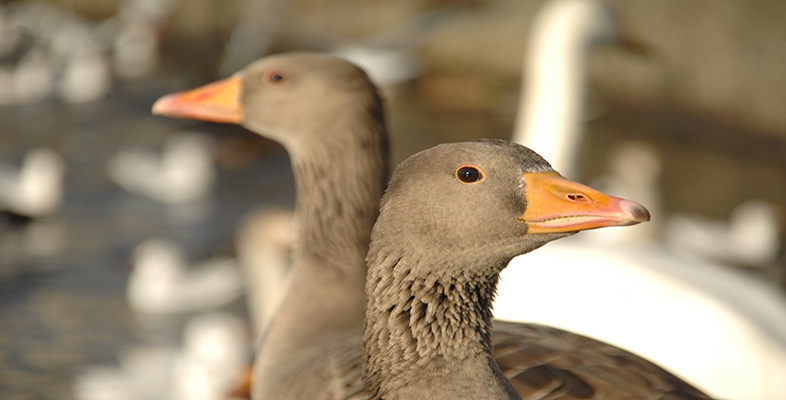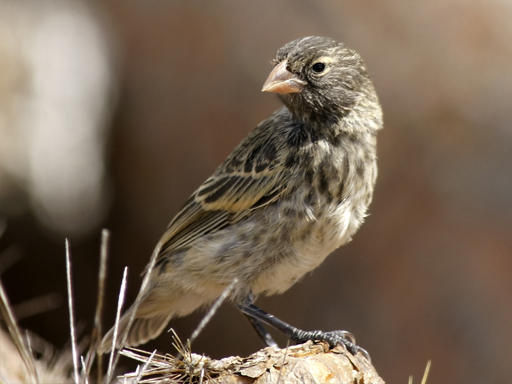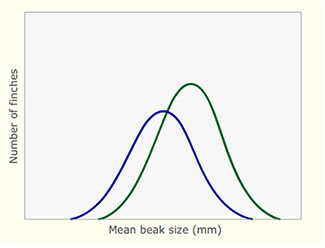3.4 Natural selection in Darwin's finches
An influential study of natural selection in birds illustrates how effective, and rapid, natural selection can be. Scientists Peter and Rosemary Grant studied the medium ground finch (Geospiza fortis, Figure 16) over a long period of time, on the Galápagos island of Daphne Major. See also Video 5.
Transcript: Video 5 An introduction to Darwin's finches.
In these finches, beak size is heritable, meaning that adults with large beaks pass large beak size onto their offspring. Figure 17 illustrates this relationship.
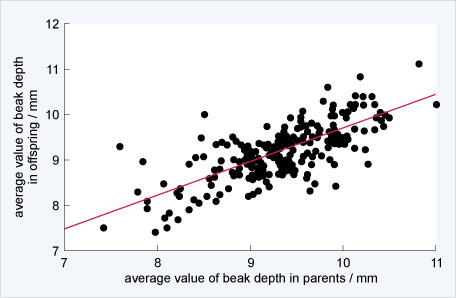
During 1977 there was a major drought on Daphne Major and many of the plants on the island produced few or no seeds. The medium ground finch population, which depends on seeds for food, declined drastically from about 1400 individuals to a few hundred in just over two years.
What the Grants' research group observed was that following the drought the population of finches had recovered; but now, the average size of the beaks was larger. The underlying reason for this was that during the drought, small seeds were exceedingly rare but large seeds with thick husks were still available. Only the large birds with large beaks were able to crack open the husks and eat the contents of the seeds. Smaller birds with smaller beaks were unable to do so and therefore starved. From this differential pattern of death, there was a rapid change in the finch population. Figure 18 illustrates how natural selection caused a rapid change in the size of the beaks in the finch population following the drought.
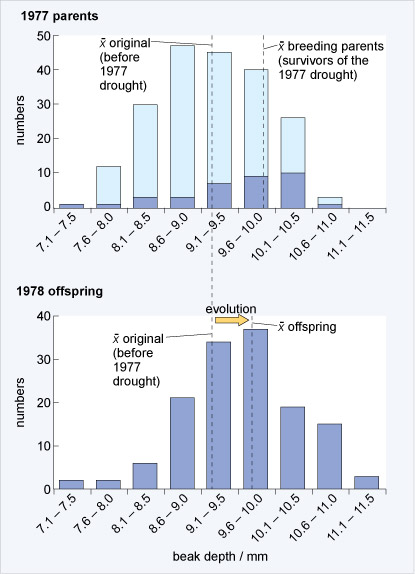
What was the difference in average beak size of all adults before the drought in 1977 and the average beak size of adults that survived the drought?
Before the drought, the average size of adult beaks was 9.2 mm. The average beak size of adults that survived was 9.9 mm.
Explain how the average beak size of birds changed from before the drought in 1977 to after the drought in 1978, once the population had recovered and started to breed again.
Before the drought, the average size was around 9.2 mm. After the drought, it shifted to around 9.7 mm.
Taking the information from Figures 17 and 18 into account, explain how natural selection could have caused an increase in beak size in this population of ground finches.
The adult survivors of the drought were the ones with the largest beaks because they could still crack large seeds. These birds then mated and because beak size is heritable and is passed on to offspring, the chicks from these birds inherited large beak size. Birds with large beaks therefore produced a large fraction of the next generation and because of this, the average size of beaks of medium ground finches increased quickly within the population.
What type of selection is operating in this example?
Directional selection.
What is important to note here is that the genetic variation that underlies differences in beak size was already present in the population. As a consequence of natural selection, the frequency of genetic variants that expressed the larger beak size increased in the population and those variants that expressed smaller beak size declined in frequency and may even be lost from the population.
From this example, you can see how dramatic changes can occur in a population as a result of natural selection. You can also see how careful observation by the Grants over consecutive years allowed them to capture empirical evidence of natural selection.
Activity 1 Finch beak size and population distribution
Use the resources to answer the interactive questions on finch population distributions.
During their migratory journeys, birds encounter extremes of temperature, storms, changes in altitude and shortage of food and water. Birds have evolved a suite of remarkable physiological adaptations to deal with these changes in the external environment. Before discussing some of these adaptations, how organisms in general maintain a constant internal environment is explored, a process known as homeostasis.
